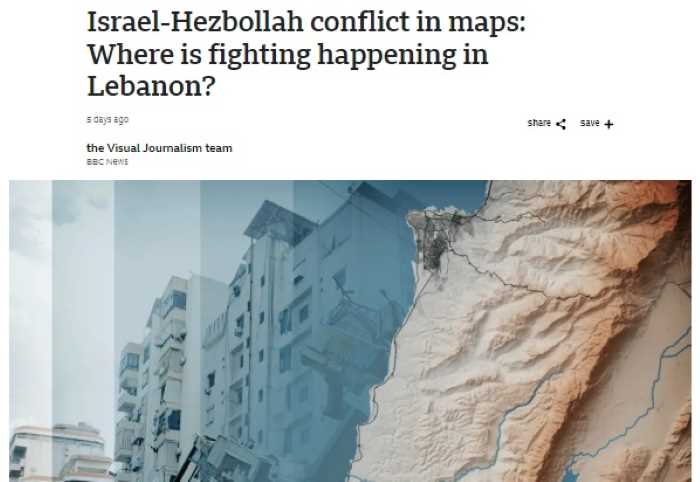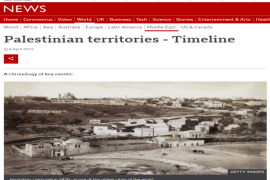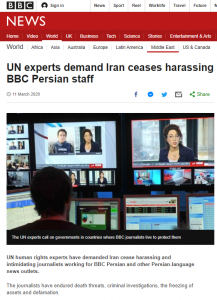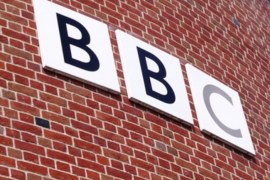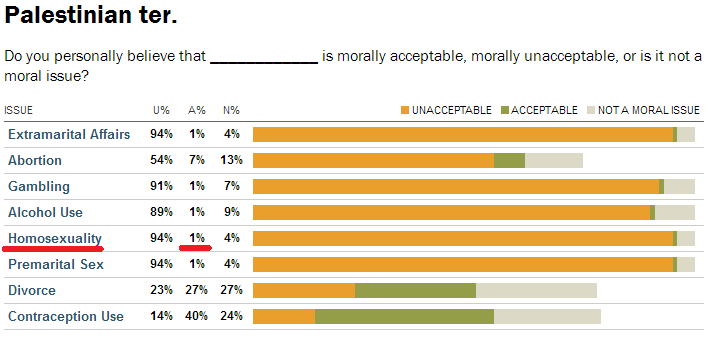Readers may recall that back in July the BBC News website published a report which was credited, among many others, to the BBC World Service Visual Journalism team:
MORE PROMOTION OF THE BBC’S SELECTIVE NARRATIVE ON HIZBALLAH
Under the sub-heading “Concerns over escalation”, that report presented the following graphic:
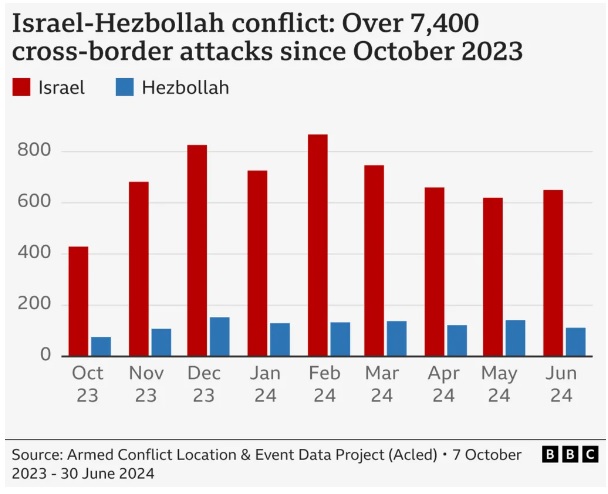
As we see, according to that graphic the number of attacks launched by Hizballah in June 2024 was somewhere around a hundred. Notably, the BBC’s graph does not mention attacks launched by other groups based in Lebanon, even though such incidents have taken place.
According to data gathered by the Jewish Institute for National Security of America (JINSA):
“In June, Hezbollah and other terrorists in Lebanon launched roughly 1,020 rockets, missiles, and drones at Israel, the highest number since the war began and an 18 percent increase over the previous high of over 860 projectiles in May, according to JINSA’s data. […]
In particular, Hezbollah launched at least 130 drones in June, roughly a 120 percent increase over the previous high of 59 it launched in December.”
JINSA provided the following graphic showing data gathered up to the end of June:
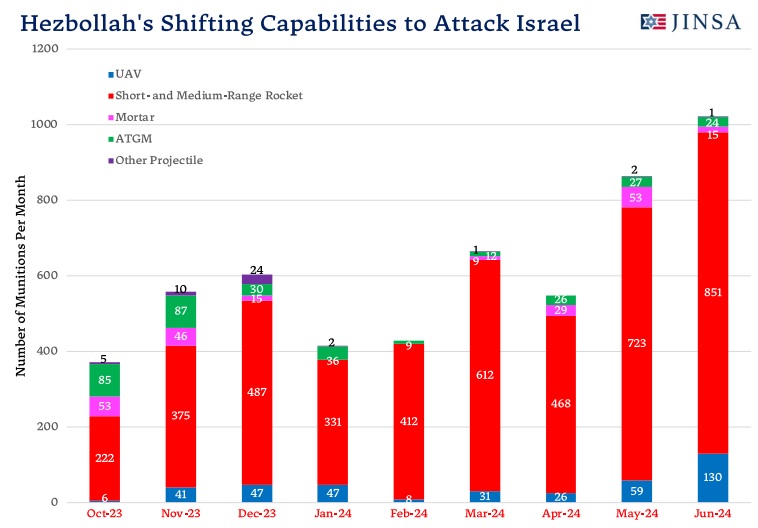
So how did over a thousand rocket, drone, mortar and anti-tank missile attacks in June become around a hundred Hizballah cross-border attacks according to the BBC’s graphic?
As pointed out by Mark Zlochin, the answer to that question appears to lie with the source of the BBC’s data – the US based organisation ACLED.

Last week the BBC News website published an updated version of a report that originally appeared on October 1st and is credited to “the Visual Journalism team” under the headline “Israel-Hezbollah conflict in maps: Where is fighting happening in Lebanon?”.
That report also includes a graphic based on data sourced from ACLED but, as in the July report, readers are not told that ACLED data is sourced from “local” partners, including anonymous sources. In the case of Israel, its declared “local” partners are the Omega Research Foundation (based in Manchester, UK), Liveuamap (based in the US) and an Irish political NGO called ‘Front Line Defenders’.

The BBC Visual Journalism team’s graphic purports to show “Weekly reported attacks”, including “Hezbollah attacks on Israel” but once again ignores attacks by other terrorist organisations.

With the cut-off date stated as being September 27th, the last purple column – which again shows around a hundred Hizballah attacks – would relate to the week September 21st to 27th.
JINSA’s report for September 2024 includes the following:
“In the month before Iran’s missile attack targeting Israel on October 1 [i.e. September – Ed.], Hezbollah launched over twice as many projectiles against Israel as any other month since the war began.”
JINSA recorded 2,162 attacks by Hizballah in September.
“In September, Hezbollah and other terrorists in Lebanon launched 132 percent more rockets, missiles, and drones at Israel than in August, according to JINSA’s data, further escalating the already heightened rate of fire that the Iran-backed group began in mid-May. Israel faced over 2,162 projectiles from Lebanon during September, up from 924 in August, an escalation that preceded Iran’s massive attack of 181 ballistic missiles on October 1.”
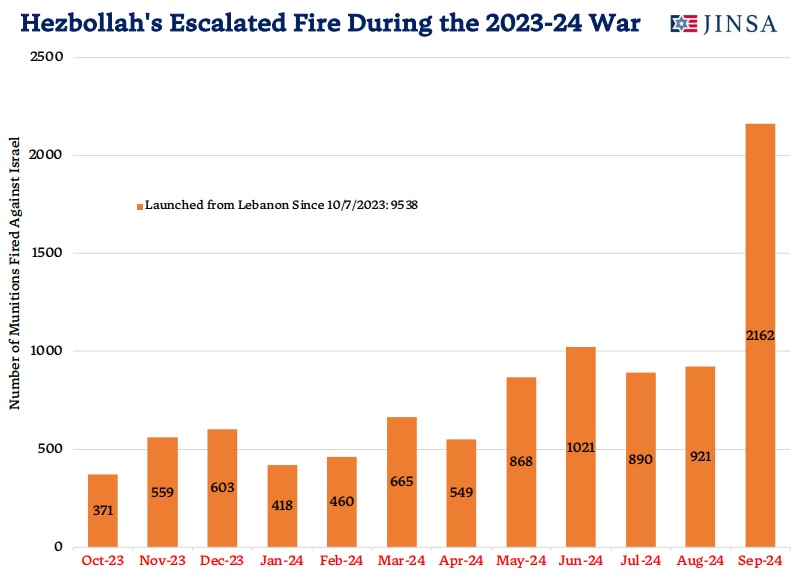
JINSA notes that in the period around the week portrayed in the last entry on the BBC’s graph showing about a hundred attacks:
“Hezbollah conducted two phases of elevated fire against Israel in September.
– From September 20-24, it mounted a substantial escalation after the September 20 assassination of Ibrahim Aqil, the head of Hezbollah’s military operations and the acting commander of its Radwan Force, along with at least 15 other Hezbollah commanders.
– From September 25-30, Hezbollah decreased the number of its attacks by but continued to launch a high number of attacks compared to earlier in September.”
And:
“Hezbollah attacks since September 20 have targeted locations in Israel further south than it has typically fired against over the past year, including against Tel Aviv, Jerusalem, Haifa, the West Bank, and Israel’s Karish gas facility in the Mediterranean Sea.”
According to the data gathered by JINSA, the average number of Hizballah attacks per day during the period between September 20th and September 24th was 167 – i.e. higher than the total number of attacks presented for the week September 21st to September 27th on the BBC’s chart.
“The terrorist group launched an average of 83 rockets and unmanned aerial vehicles (UAV) per day from September 25-30, down from an average of 167 per day from September 20-24.”
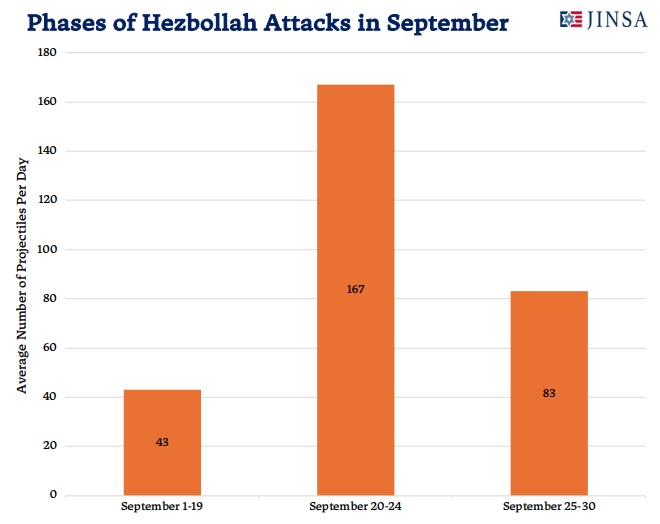
The paragraph immediately preceding the BBC’s ACLED sourced graph reads as follows:
“As the chart below shows, the number of weekly Israeli attacks on Lebanon more than tripled in the week before the IDF launched its ground invasion. The number of Hezbollah attacks, while small in comparison, also increased in the same week.” [emphasis added]
The chart itself tells BBC audiences that “Israeli attacks intensified prior to invasion of southern Lebanon”.
While that may be the case (as one would expect prior to the entry of ground troops), notably, the data presented by the BBC does not take into account the fact that some of those “Israeli attacks” may well have the targeted rocket launchers used by Hizballah to carry out an increased rate of attacks during that week. In other words, the BBC’s portrayal of Israeli attacks does not differentiate between attacks on military targets and attacks on infrastructure that has been used by Hizballah to launch attacks on Israel.
The BBC’s chart states that “Attacks include airstrikes, artillery, missiles, shelling, armed clashes and remote explosives”. Readers are not however provided with definitions of those categories and while some may be self-explanatory, “remote explosives” is certainly not.
ACLED’s Codebook includes the following definitions: [emphasis added]
“Explosions/Remote violence
ACLED defines ‘Explosions/Remote violence’ events as incidents in which one side uses weapon types that, by their nature, are at range and widely destructive. The weapons used in ‘Explosions/Remote violence’ events are explosive devices, including but not limited to: bombs, grenades, improvised explosive devices (IEDs), artillery fire or shelling, missile attacks, air or drone strikes, and other widely destructive heavy weapons or chemical weapons. Suicide attacks using explosives also fall under this category. When an ‘Explosions/Remote violence’ event is reported in the context of an ongoing battle, it is merged and recorded as a single ‘Battles’ event. ‘Explosions/Remote violence’ can be used against armed agents as well as civilians. ‘Explosions/Remote violence’ events where civilians are the main or only target will be tagged with “Civilians targeted” in the ‘Civilian targeting’ column.
The following sub-event types are associated with the ‘Explosions/Remote violence’ event type: ‘Chemical weapon’, ‘Air/drone strike’, ‘Suicide bomb’, ‘Shelling/artillery/missile attack’, ‘Remote explosive/landmine/IED’, and ‘Grenade’.”
“Shelling/artillery/missile attack
This sub-event type captures the use of long-range artillery, missile systems, or other heavy weapons platforms in the absence of any other engagement. When two armed groups exchange long-range fire, it is recorded as an ‘Armed clash’. ‘Shelling/artillery/missile attack’ events include attacks described as shelling, the use of artillery and cannons, mortars, guided missiles, rockets, grenade launchers, and other heavy weapons platforms. Crewed aircraft shot down by long-range systems fall under this sub-event type. Uncrewed armed drones that are shot down, however, are recorded as interceptions under ‘Disrupted weapons use’ because people are not targeted. Similarly, an interception of a missile strike itself (such as by the Iron Dome in Israel) is also recorded as ‘Disrupted weapons use’.”
“Disrupted weapons use
This sub-event type is used to capture all instances in which an event of ‘Explosions/Remote violence’ is prevented from occurring, or when armed actors seize significant caches of weapons. It includes the safe defusal of an explosive, the accidental detonation of explosives by those allegedly responsible for planting it, the interception of explosives in the air, as well as the seizure of weapons or weapons platforms such as jets, helicopters, tanks, etc. Note that in cases where a group other than the one that planted an explosive is attempting to render an explosive harmless and it goes off, this is recorded under the ‘Explosions/Remote violence’ event type, as the explosive has harmed an actor other than the one that planted it.”
The BBC’s chart does not state that it includes “disrupted weapons use” and so we do not know whether or not it includes UAV interceptions by Israeli aircraft or Iron Dome interceptions of missiles. Neither does the BBC’s graph include any “civilians targeted” tagging as would, for example, have been applicable to the September 8th rocket attacks on Kibbutz Shamir or the September 9th drone attack on a residential building in Nahariya.
What we do see, however, is that ACLED states that attacks such as the thirty rockets fired at Kibbutz Shamir are “merged and recorded as a single ‘Battles’ event”. In other words, it does not matter whether Hizballah fired one rocket, thirty rockets or 160 rockets: the documentation is the same.
That perhaps goes some way towards explaining how the BBC’s sourcing and use of data from that organisation has repeatedly resulted in its audiences being presented with information that misleads them on issue of the actual the number of attacks on Israelis perpetrated by the Hizballah terrorist organisation.
Related Articles:

